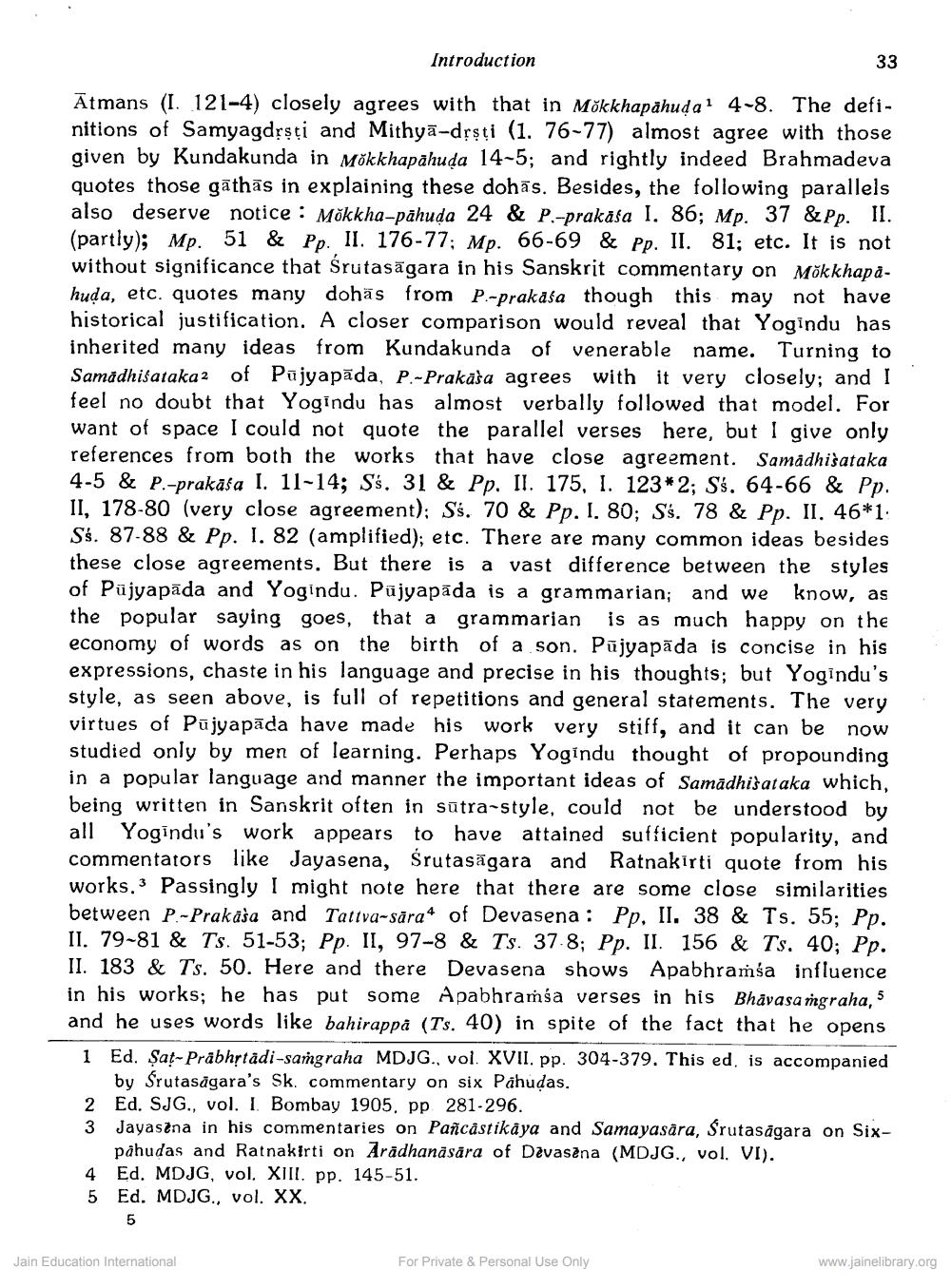________________
Introduction
33
Ātmans (I. 121-4) closely agrees with that in Mökkhapähudai 4-8. The definitions of Samyagdrsti and Mithyā-drsti (1. 76-77) almost agree with those given by Kundakunda in Mökkhapähuda 14-5; and rightly indeed Brahmadeva quotes those gāthās in explaining these dohās. Besides, the following parallels also deserve notice : Mökkha-pähuda 24 & P.-prakäsa I. 86; Mp. 37 & Pp. II. (partly); Mp. 51 & Pp. II. 176-77; Mp. 66-69 & Pp. II. 81; etc. It is not without significance that Srutasägara in his Sanskrit commentary on Mõkkhapahuda, etc. quotes many dohās from P.-prakasa though this may not have historical justification. A closer comparison would reveal that Yogindu has inherited many ideas from Kundakunda of venerable name. Turning to Samadhisataka2 of Pujyapāda, P.-Prakāša agrees with it very closely; and I feel no doubt that Yogindu has almost verbally followed that model. For want of space I could not quote the parallel verses here, but I give only references from both the works that have close agreement. Samadhisataka 4-5 & P.-prakasa I. 11-14; $s. 31 & Pp. II. 175, I. 123*2; Ss. 64-66 & Pp. II, 178-80 (very close agreement); $s. 70 & Pp. I. 80; Ss. 78 & Pp. II. 46*1. Şś. 87-88 & Pp. I. 82 (amplified); etc. There are many common ideas besides these close agreements. But there is a vast difference between the styles of Pujyapāda and Yogindu. Pūjyapāda is a grammarian; and we know, as the popular saying goes, that a grammarian is as much happy on the economy of words as on the birth of a son. Pūjyapāda is concise in his expressions, chaste in his language and precise in his thoughts; but Yogindu's style, as seen above, is full of repetitions and general statements. The very virtues of Pujyapāda have made his work very stiff, and it can be now studied only by men of learning. Perhaps Yogindu thought of propounding in a popular language and manner the important ideas of Samadhišataka which, being written in Sanskrit often in sūtra-style, could not be understood by all Yogindu's work appears to have attained sufficient popularity, and commentators like Jayasena, Srutasāgara and Ratnakirti quote from his works.3 Passingly I might note here that there are some close similarities between P.-Prakáša and Tattva-sära4 of Devasena : Pp. II. 38 & Ts. 55; Pp. II. 79-81 & Ts. 51-53; Pp. II, 97-8 & Ts. 37-8; Pp. II. 156 & Ts. 40; Pp. II. 183 & Ts. 50. Here and there Devasena shows Apabhramśa influence in his works; he has put some Apabhraíśa verses in his Bhavasa ngraha, 5 and he uses words like bahirappå (Ts. 40) in spite of the fact that he opens 1 Ed. Şat-Prabhstādi-sangraha MDG., vol. XVII. pp. 304-379. This ed, is accompanied
by Srutasagara's Sk. commentary on six Pahudas. 2 Ed. SJG., vol. I Bombay 1905. pp 281-296.
Jayasina in his commentaries on Pañcastikaya and Samayasära, Śrutasagara on Six
pähudas and Ratnakirti on Arādhanāsära of Devasèna (MDJG., vol. VI). 4 Ed. MDJG, vol. XIII. pp. 145-51. 5 Ed. MDJG., vol. XX.
Jain Education International
For Private & Personal Use Only
www.jainelibrary.org




